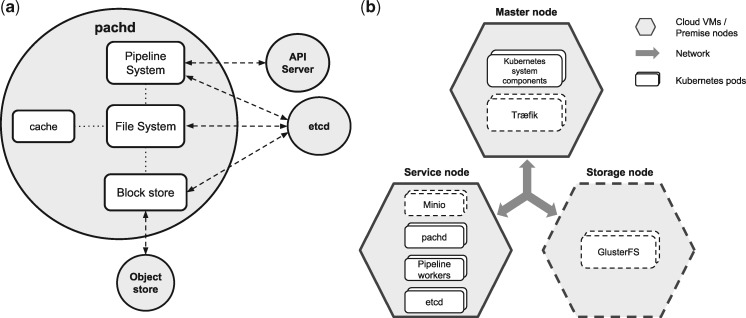Fig. 1.
(a) The Pachyderm daemon. pachd is the Pachyderm daemon managing the pipelining and data versioning features of Pachyderm. The main components of pachd are (i) a file system component, (ii) a block store component and (iii) a pipelining component. The file system component handles all requests related to putting data into and getting data out of Pachyderm Data Repositories (PDRs). To this end, the file system component cooperates with the block store component to content address new data, put new objects in the backing object store, pull objects out of the backing object store, etc. The pipelining system component creates and manages all of the pipeline workers, which execute to process data in Pachyderm pipelines. The pipelining system component cooperates with the file system component to make sure that the correct subsets/versions of data (versioned in PDRs) are provided to the correct pipeline workers, such that data is processed in the sequence and manner specified by users. To coordinate and track all of these actions, pachd stores and queries metadata in etcd, a distributed key/value store that is also deployed in a pod on Kubernetes, and it communicates with the Kubernetes API Server and the backing object-store service. Further, Pachyderm optimizes uploads/downloads of data via an internal caching system. (b) A typical infrastructure and services setup with Pachyderm. A standard Kubernetes cluster contains two major entities represented in two different polygonal figures. Cloud VMs/premise nodes are depicted as hexagons, whereas Kubernetes pods are displayed as rounded rectangles. Optional nodes/pods are depicted with dashed borders. The master node coordinates the rest of the nodes, runs the Kubernetes API and can use a reverse proxy such as Træfik (https://traefik.io/). In the service nodes, all Pachyderm related pods are scheduled: the Pachyderm daemon, Pachyderm pipeline workers and etcd. Also, Minio services can be deployed in service nodes, responsible for upload/download of data to/from the backing storage. The storage dedicated node (optional) is in charge of providing application containers with a shared file system (e.g. GlusterFS), using block storage volumes

